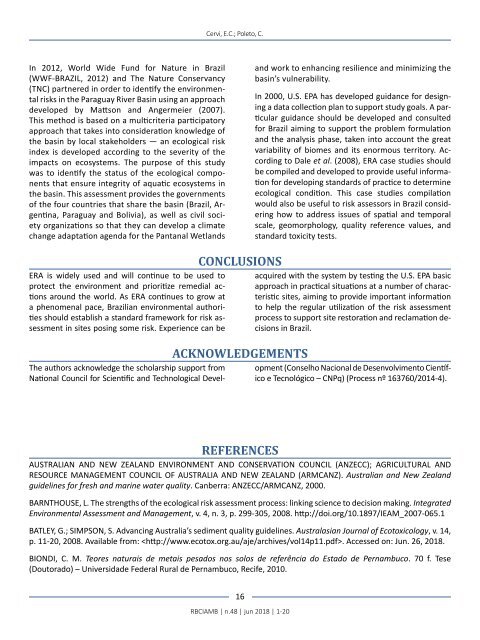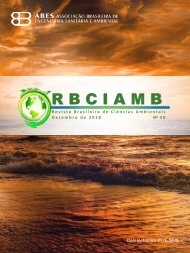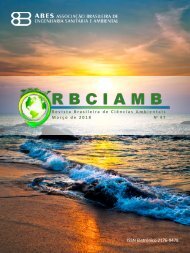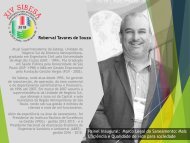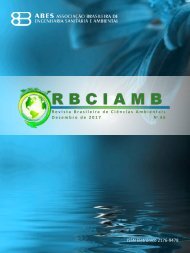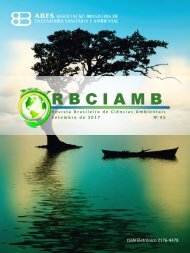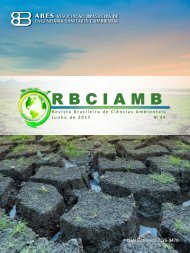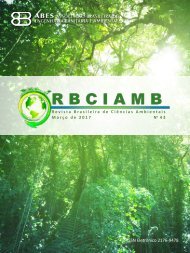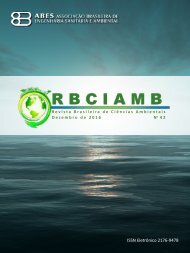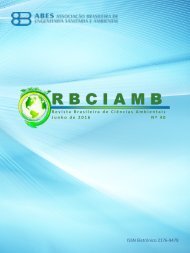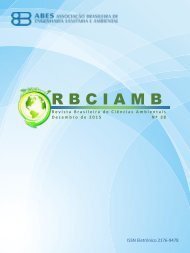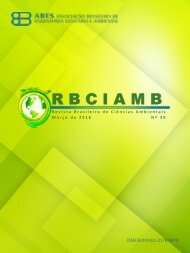Edição 48 RBCIAMB
You also want an ePaper? Increase the reach of your titles
YUMPU automatically turns print PDFs into web optimized ePapers that Google loves.
Cervi, E.C.; Poleto, C.<br />
In 2012, World Wide Fund for Nature in Brazil<br />
(WWF-BRAZIL, 2012) and The Nature Conservancy<br />
(TNC) partnered in order to identify the environmental<br />
risks in the Paraguay River Basin using an approach<br />
developed by Mattson and Angermeier (2007).<br />
This method is based on a multicriteria participatory<br />
approach that takes into consideration knowledge of<br />
the basin by local stakeholders — an ecological risk<br />
index is developed according to the severity of the<br />
impacts on ecosystems. The purpose of this study<br />
was to identify the status of the ecological components<br />
that ensure integrity of aquatic ecosystems in<br />
the basin. This assessment provides the governments<br />
of the four countries that share the basin (Brazil, Argentina,<br />
Paraguay and Bolivia), as well as civil society<br />
organizations so that they can develop a climate<br />
change adaptation agenda for the Pantanal Wetlands<br />
and work to enhancing resilience and minimizing the<br />
basin’s vulnerability.<br />
In 2000, U.S. EPA has developed guidance for designing<br />
a data collection plan to support study goals. A particular<br />
guidance should be developed and consulted<br />
for Brazil aiming to support the problem formulation<br />
and the analysis phase, taken into account the great<br />
variability of biomes and its enormous territory. According<br />
to Dale et al. (2008), ERA case studies should<br />
be compiled and developed to provide useful information<br />
for developing standards of practice to determine<br />
ecological condition. This case studies compilation<br />
would also be useful to risk assessors in Brazil considering<br />
how to address issues of spatial and temporal<br />
scale, geomorphology, quality reference values, and<br />
standard toxicity tests.<br />
ERA is widely used and will continue to be used to<br />
protect the environment and prioritize remedial actions<br />
around the world. As ERA continues to grow at<br />
a phenomenal pace, Brazilian environmental authorities<br />
should establish a standard framework for risk assessment<br />
in sites posing some risk. Experience can be<br />
CONCLUSIONS<br />
ACKNOWLEDGEMENTS<br />
acquired with the system by testing the U.S. EPA basic<br />
approach in practical situations at a number of characteristic<br />
sites, aiming to provide important information<br />
to help the regular utilization of the risk assessment<br />
process to support site restoration and reclamation decisions<br />
in Brazil.<br />
The authors acknowledge the scholarship support from<br />
National Council for Scientific and Technological Development<br />
(Conselho Nacional de Desenvolvimento Científico<br />
e Tecnológico – CNPq) (Process nº 163760/2014-4).<br />
REFERENCES<br />
AUSTRALIAN AND NEW ZEALAND ENVIRONMENT AND CONSERVATION COUNCIL (ANZECC); AGRICULTURAL AND<br />
RESOURCE MANAGEMENT COUNCIL OF AUSTRALIA AND NEW ZEALAND (ARMCANZ). Australian and New Zealand<br />
guidelines for fresh and marine water quality. Canberra: ANZECC/ARMCANZ, 2000.<br />
BARNTHOUSE, L. The strengths of the ecological risk assessment process: linking science to decision making. Integrated<br />
Environmental Assessment and Management, v. 4, n. 3, p. 299-305, 2008. http://doi.org/10.1897/IEAM_2007-065.1<br />
BATLEY, G.; SIMPSON, S. Advancing Australia’s sediment quality guidelines. Australasian Journal of Ecotoxicology, v. 14,<br />
p. 11-20, 2008. Available from: . Accessed on: Jun. 26, 2018.<br />
BIONDI, C. M. Teores naturais de metais pesados nos solos de referência do Estado de Pernambuco. 70 f. Tese<br />
(Doutorado) – Universidade Federal Rural de Pernambuco, Recife, 2010.<br />
16<br />
<strong>RBCIAMB</strong> | n.<strong>48</strong> | jun 2018 | 1-20


